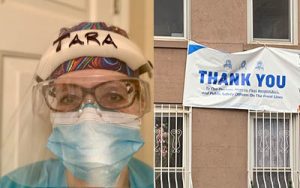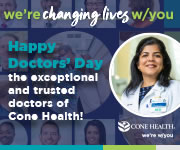 After agreeing to travel to New York City (NYC) to help patients with COVID-19 in one of hardest hit cities in the nation, Tara Tomlinson, a critical care nurse with Novant Health Kernersville Medical Center (KMC), shares what it was like to serve on the front lines.
After agreeing to travel to New York City (NYC) to help patients with COVID-19 in one of hardest hit cities in the nation, Tara Tomlinson, a critical care nurse with Novant Health Kernersville Medical Center (KMC), shares what it was like to serve on the front lines.
Tomlinson has been a nurse for almost 12 years and has worked at KMC for a little over two years.
Tomlinson said she signed up to go to NYC to help because they were getting burdened with the lack of staff there.
“I just wanted to see if I could go up there and help,” she said, noting that the agency chose the location where she would be working. “I was there for two weeks, from April 12 – 26.”
After finding an agency that would allow her to go on a short-term assignment, Tomlinson took a short-term leave of absence from KMC to head to work at Maimonides Medical Center in Brooklyn, which she explained is a large teaching hospital with a large ethnically diverse Hasidic Jewish population.
“I ended up being at a very high need hospital in that area and some of it did relate to some cultural reasons,” she said, adding that pretty much the entire hospital was filled with people who had been diagnosed with the COVID-19 coronavirus.
While in NYC, Tomlinson said she worked in a variety of intensive care units (ICU), adding that the hospital turned “every nook and cranny” into an ICU due to the intense need. She mentioned that some units even had two patients to a room where there would normally be one.
Tomlinson said it was a scary experience.
“I think it is scary because of what you’re dealing with. I think it’s a little more somber and quieter than we’re used to a hospital being, but it was always very busy,” she shared.
Like many hospitals right now, Tomlinson said there wasn’t a lot of visitation, so she didn’t have a lot of interaction with families, but she said there were a few cases where a rabbi would be in a room with a patient.
Tomlinson said almost every patient she had was intubated, so she didn’t interact with them.
“There weren’t any quick ICU patients, and most were there for extended periods of time,” she said. “The patients are really sick.”
The youngest person Tomlinson said she saw in the ICU was in their 30s and noted that she easily saw patients in their 40s that weren’t going to make it out.
Tomlinson said she took care of a male patient who had been there for three weeks in the ICU, who was in his 40s, had kids and didn’t have a lot of past medical history.
With the number of people that were taken by the virus, Tomlinson said there was a refrigerated area that had to be set up next to the hospital to make room for the bodies because they ran out or room in the hospital morgue.
“There was an overwhelming sense of sadness there,” she said, noting that every day that she walked to the hospital, the refrigerated area outside of the hospital would grow due to the number of bodies being stored there.
“These patients aren’t numbers; they are real people with families,” she said. “I think it is easy to look at all of these numbers, but we have to remember that these numbers are fathers, mothers, aunts and uncles, family members and rabbis. It’s difficult to look at these patients and think they aren’t going to make it.”
To protect herself and the people around her, Tomlinson wore her personal protective equipment (PPE) about 13 hours a day, and had marks on her face at the end of each day after removing her glasses, mask, and face shield.
Outside of the hospital, Tomlinson said it wasn’t much different in regards to being quiet and somber.
She stayed in a hotel near the hospital mostly walked to work. She also took the subway some.
“I’ve been to NYC before and how quiet the city was, it was like a ghost town. It’s nothing like the NYC you know. Usually, it’s noisy all the time and there weren’t many cars on the road,” she said.
While it was somber, Tomlinson explained that there was a sense of hope from those she came across who had a deep respect for medical staff.
She said in the elevators, there were cards posted and she had a little area in her hotel room where she kept cards and flowers she received from friends, staff from KMC and her family.
“My grandkids sent me pictures, so every time I came (to my hotel), I saw them,” she said. “Even walking along the street the first night there, when I started thinking ‘what have I done’ after doing orientation, there were three or four people who put their heads out of their window and said, ‘We love you.’ It was just so encouraging.”
Another day Tomlinson said she felt encouraged was when she was walking on the sidewalk and a guy, in what she called true NY fashion, waited until he was right next to them as he passed, put his head down and said, “Thank you guys.”
“It’s those non-grand gestures that really keep you going when you reach the end of your rope,” she shared.
After returning from spending two weeks in NYC, Tomlinson had to self-quarantine for two weeks before she could return to work. She also explained that her husband is in a high-risk category, so she had to stay confined to a room in her home, where her kids set up a room in their house with a mini-fridge to help make those two weeks a little more comfortable.
Having spent two weeks in an area with so many cases, Tomlinson said it made the pandemic and the threat very real for her.
“I have dealt with patients before, but this made it so incredibly real. There wasn’t a patient that wasn’t positive. The suffering is real and it makes you realize how bad it can get,” she said. “So, now that I’m here and people aren’t taking it seriously, it is hard because I’ve seen the worst-case scenario.”
Having been on the front lines with dying patients and seeing the pandemic first hand for all that it can be, Tomlinson has a message for those around her.
“I want people to realize that not only are these actual people’s families, but this also isn’t a time for paralyzing fear or a time for blatant disregard. We need to respect it and take it seriously,” she said. “We are doing these things to not only protect ourselves, but also all the people in the community.”
Tomlinson added that as restrictions are being lessened, she wants people to remember that it doesn’t mean the virus is gone.
“We still need to be cautious and continue to take it seriously,” she said. “A lot of what we are doing is to protect other people. There are a lot of people that are in an uproar over wearing a mask, but we’re protecting others. You can be asymptomatic and easily pass it on to someone.”
While Tomlinson took a risk to help people in NYC, she said it feels small in comparison to what other medical staff there have been doing.
“I feel like what I did was very small compared to what those NYC nurses had gone through. It was overwhelming and life changing,” she said.
Front line news on Covid-19
Previous post: Church worship
Next post: COVID-19 updates









